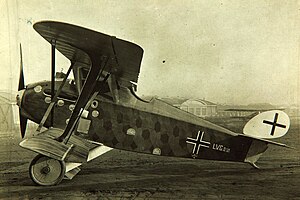Engineering:LVG D.VI
From HandWiki
Short description: WWI German prototype fighter aircraft
| LVG D.VI | |
|---|---|

| |
| Role | Fighter |
| Manufacturer | Luft Verkehrs Gesellschaft (LVG) |
| First flight | November 1918 |
| Number built | 1 |
The LVG D.VI was a prototype German biplane fighter built by LVG in World War I.
Design
The D.VI was a single-seat biplane fighter which featured a slab-sided plywood-covered fuselage as well as an almond-shaped rudder. Unlike the LVG D.V, the D.VI had more conventional wings, the upper wing being larger and having curved tips and ailerons, and the lower wing being smaller and being swept back. The wings were connected by I struts, with wire cross bracing.[1]
Specifications
General characteristics
- Crew: 1
- Length: 7.2 m (23 ft 7 in)
- Wingspan: 8.8 m (28 ft 10 in)
- Height: 2.9 m (9 ft 6 in)
- Wing area: 18.8 m2 (202 sq ft)
- Empty weight: 670 kg (1,477 lb)
- Powerplant: 1 × Benz Bz.IIIbm V-8 water-cooled piston engine, 138 kW (185 hp) -150 kW (200 hp)
- Propellers: 2-bladed fixed-pitch propeller
Performance
- Maximum speed: 198 km/h (123 mph, 107 kn)
- Cruise speed: 170 km/h (110 mph, 92 kn)
Armament
- Guns: 2 × 7.92 mm (0.312 in) LMG 08/15 machine guns
References
- ↑ Rickard, J. (8 September 2014). "LVG D.VI". http://www.historyofwar.org/articles/weapons_LVG_DVI.html. Retrieved 1 February 2019.
Further reading
- Gray, Peter; Thetford, Owen (1970). German Aircraft of the First World War (2nd ed.). London: Putnam. p. 483. ISBN 0-370-00103-6. https://archive.org/details/germanaircraftfi00thet.
- Herris, Jack (2019). LVG Aircraft of WWI: Volume 3: C.VI–C.XI & Fighters: A Centennial Perspective on Great War Airplanes. Great War Aviation Centennial Series. 36. Charleston, South Carolina: Aeronaut Books. ISBN 978-1-935881-74-2.
 |

